Coordinación
Una coordinación sólida puede evitar vacíos y duplicaciones en las respuestas humanitarias, así como garantizar que los PTM complementen otros tipos de asistencia. Sin embargo, el informe del «Estado Global de los Programas de Transferencias Monetarias» de la CALP Network muestra que la coordinación de la asistencia en efectivo es vista como débil y ad hoc, y que esto está teniendo graves repercusiones operativas.
Los donantes, las ONG y los líderes de los grupos de trabajo de transferencias monetarias (GTM) han pedido claridad sobre tres temas principales relacionados con la coordinación de la asistencia en efectivo:
- Quién debe ser responsable de asegurar una coordinación eficaz de la asistencia en efectivo;
- Cuál es la función y el mandato de los grupos de trabajo de transferencias monetarias, incluso en relación con las transferencias monetarias multipropósito;
- Cómo se debe dotar de recursos a la coordinación de asistencia en efectivo.
Tenemos que basarnos urgentemente en lo que funciona y proporcionar claridad a nivel mundial sobre las preguntas arriba mencionadas, adaptándonos a los diferentes contextos. Hace mucho tiempo que se deberían haber tomado decisiones claras basadas en necesidades operativas y no en la política de las agencias.
Prioridades actuales
El objetivo de la CALP Network es contribuir a seguir progresando en este tema en tres niveles: apoyar a los grupos de trabajo de transferencias monetarias a nivel regional; contribuir a soluciones prácticas para la coordinación de la asistencia en efectivo a nivel mundial; y convocar una discusión basada en la evidencia sobre temas clave, destacando puntos de decisión críticos y oportunidades de progreso.
Contenido destacado
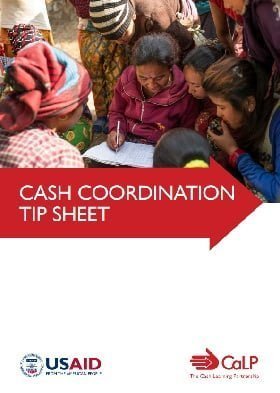
Cash Coordination Tip Sheet
Guidelines and Tools
This tip sheet sets out established best practice, key guidance and resources for all aspects of cash coordination, intended as a clear, accessible and action-oriented guide for those engaged in coordination of cash and voucher assistance (CVA) at the field level.
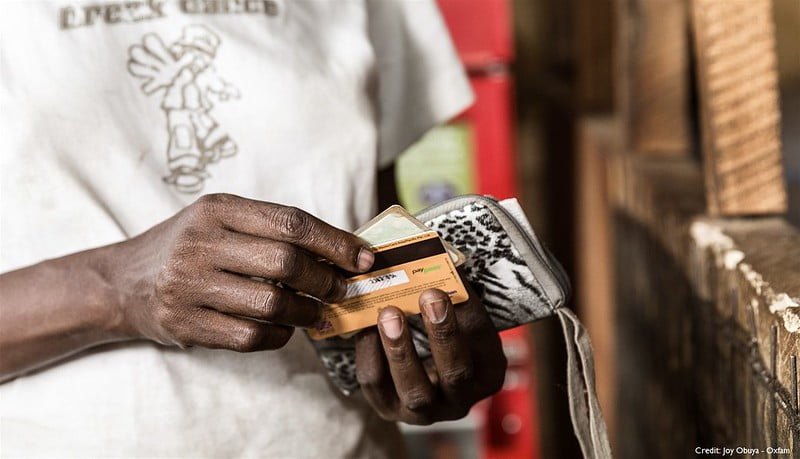
Introducing the Cash Coordination Tip Sheet
Webinar
The CALP Network has developed a tipsheet setting out established best practice and key guidance and resources for all aspects of cash coordination, intended as a clear, accessible and action-oriented guide for those engaged in coordination of cash and voucher assistance at the field level.

Cash Coordination: A proposal from members in MENA
Blog Post
Earlier this year the CALP Network undertook regional consultations to explore options for cash coordination. This blog lays out recommendations from participants from the Middle East and North Africa who sketched out what cash coordination, and coordination more broadly, could look like in future to support a more effective, efficient and accountable response.
Últimos recursos
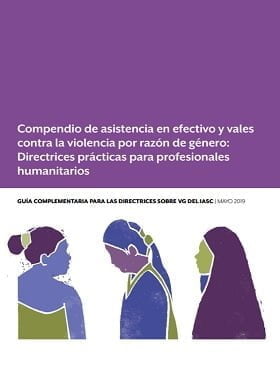
Compendio de asistencia en efectivo y vales contra la violencia por razón de género: Directrices prácticas para profesionales humanitarios
Guía y herramientas
El propósito de este compendio de asistencia en efectivo y vales (AEV) y violencia por razón de género (VG) es ayudar a los actores humanitarios y a las comunidades afectadas por crisis y violencia a: integrar la mitigación de riesgos de VG en las intervenciones AEV; integrar la prevención de VG...

Multi-Purpose Cash Transfer ‘Plus’: Maximizing impact on children through integrated cash-based programming
Report
In 2018, with the support of OFDA and FFP, Save the Children implemented a multi-purpose cash transfer ‘Plus’ program in response to the influx of Venezuelan into Colombia. The program aimed at covering vulnerable household’s basic needs and prevent them from resorting to negative coping strategies,...

Webinar: Data sharing in CVA: ethics, ownership and privacy
Event

Gender, Cash Assistance, and Conflict: Gendered Protection Implications of Cash and Voucher Assistance in Somalia/Somaliland
Report
The goal of this report is to further understand protection issues in Somalia/land and the implications of CVA on gendered protection issues in the region. This report is structured in reflection of that goal. Following the executive summary, a brief introduction was offered. The section that follows the...
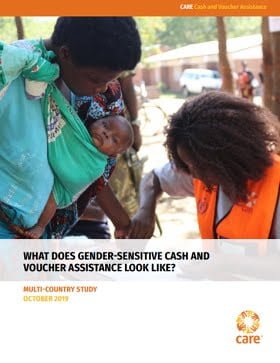
What does Gender-Sensitive Cash and Voucher Assistance Look Like?
Report
CARE commissioned a study on gender-sensitive CVA from its own project participants and took place in Haiti, Niger, Jordan, Malawi and the Philippines.
The study aimed at understanding the:
-Extent to which women, men, boys, and girls have been involved in the design of CVA and the implications of
this...

Towards Organizational Readiness for Data Responsibility: A simple framework for responsible data champions
Blog Post
This blog is the third in a series on cash and voucher assistance (CVA) and risk. While the first blog busted some myths around misappropriation and fraud in CVA, the second blog looked into a specific risk for recipients of CVA: the risk of misuse of personal data. This third, guest blog from Linda...

Cash Transfer Programming and Child Protection in Humanitarian Action: Review and opportunities to strengthen the evidence
Report
As prevalence of cash transfer programming in humanitarian response has grown, so too has the recognition that the child protection sector must learn how to use case transfer programs to achieve better results for children. This report summarizes the evidence for cash transfer programming and child...

Cost-Efficiency Analysis of Basic Needs Programs: Best Practice Guidance for Humanitarian Agencies
Guidelines and Tools
The Efficiency, Effectiveness and Value for Money Sub-Workstream is pleased to share the final output on Cost-Efficiency Analysis of Basic Needs Programs: Best Practice Guidance for Humanitarian Agencies (attached).
Cost-efficiency analysis estimates the ratio of program costs to outputs created, allowing...
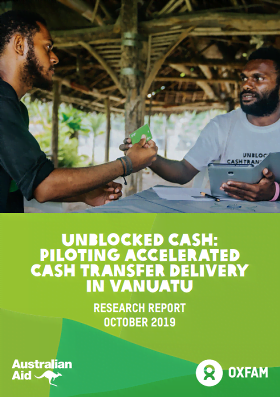
UnBlocked Cash: Piloting Accelerated Cash Transfer Delivery In Vanuatu
Report
Distributed ledger technologies (DLTs) are among the most
promising innovations to have emerged during the last decade,
with the potential to fundamentally transform existing economic,
institutional and social systems. Often referred to as ‘Blockchains’
in honour of the first example developed by...
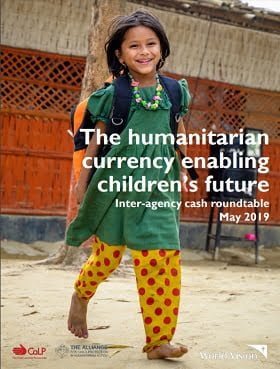
The humanitarian currency enabling children’s future – Inter-agency cash roundtable
Report
This summary report highlights key presentation insights, and recommendations from the CALP Network & World Vision co-hosted inter-agency Cash Roundtable, focusing on how CVA can be an enabler to promote child protection and child wellbeing, based on most recent research, case studies from across the...

An ABC for MPC: What multipurpose cash can and cannot do
Blog Post
Terminology Matters From cash coordination workshops in Dakar to market-based programming sessions in Geneva, anyone who has ever discussed cash and voucher assistance (CVA) in a meeting can tell you that terminology is a challenge – especially when it comes to multipurpose cash. However, speaking the...

It’s Planning Season Again – What CVA actors need to know about changes to the Humanitarian Programme Cycle
Blog Post
This time last year we wrote a planning season call to arms, urging Cash Working Groups (CWGs) and Clusters to work together for better inclusion of cash and voucher assistance (CVA) in the Humanitarian Response Plans (HRP). Well planning season has rolled around again, this time with some significant...

How Will Financial Assistance Look in 2030? Here are your thoughts so far
Blog Post
In 2030, humanitarian crises and the ways in which humanitarian needs are met will look very different from today. The role of financial assistance is growing: it is estimated that $4.8 billion was delivered in cash and voucher assistance (CVA) in 2018, as well as $686 billion in remittances, while 2.5...
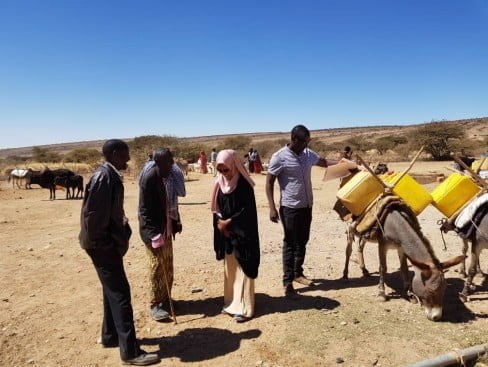
Celebrating #WomenHumanitarians from our Membership for World Humanitarian Day 2019
Blog Post
World Humanitarian Day is held every year on 19 August to pay tribute to aid workers who risk their lives in humanitarian service, and to rally support for people affected by crises around the world.

Lessons in Driving Large Scale Change: the CALP Network’s reflections from the Humanitarian Innovation Exchange
Blog Post
The scaling of cash programming, enabled by mobile money, represents one of the most significant recent innovations in the humanitarian sector. In two guest blogs for Elrha (Enhanced Learning and Research for Humanitarian Assistance), our Director Karen Peachey explores the CALP Network’s role in...

Guidance on Market Based Programming for Humanitarian WASH Practitioners
Guidelines and Tools
The purpose of this document is to provide practical guidance in preparedness, assessment, program design, implementation and monitoring related to Market-Based Programming (MBP) in humanitarian WASH assistance, and more specifically on: How to identify linkages between markets and WASH services &...

Leveraging Cash and Voucher Assistance in Gender-based Violence Prevention and Response
Blog Post
Despite a reported 60% scale-up in cash and voucher delivery from 2016-18, its use for protection outcomes – including to support the prevention of and response to gender-based violence – trails behind that of all other sectors. In our latest guest blog, Tenzin Manell of Women’s Refugee Commission...

Webinar: Help shape the Future of Financial Assistance report
Event
This webinar presented the scenarios and key issues arising from the CALP Network and IARAN's analysis and invited participants' input, ahead of the publication of the Future of Financial Assistance report

A New Blueprint for the Future of Financial Assistance
Blog Post
Ahead of our workshop on the Future of Financial Assistance in Amman on 24 and 25 July, Paula Gil Baizan, independent expert and a member of the steering committee for the CALP Network’s Future of Financial Assistance work, encourages us to re-imagine the blueprint upon which we build the future of...

Compte-rendu du Cash Working Group du Niger du 31 juillet 2019
Report